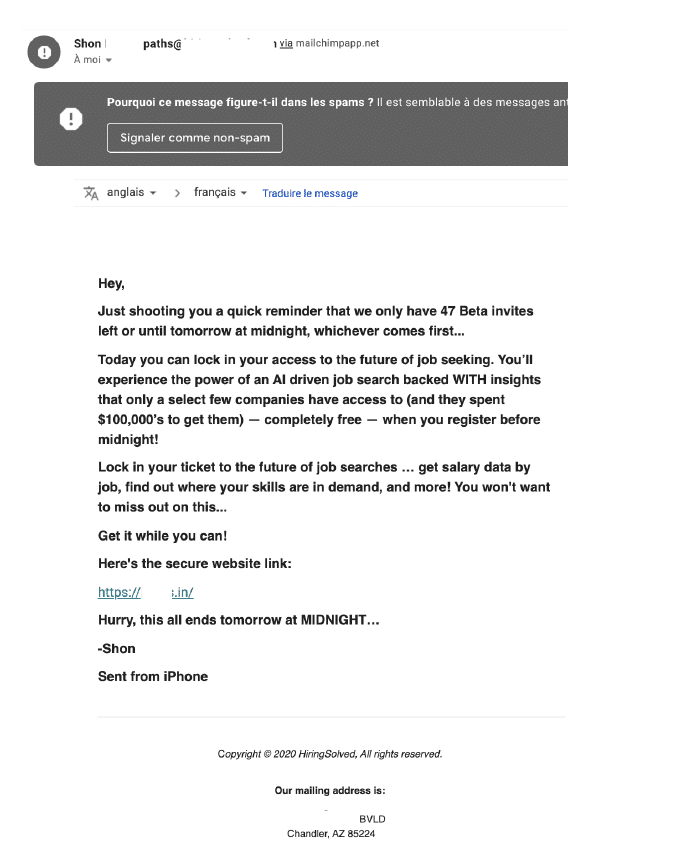- Cold Emailing Definition and Strategies Explained
- How to write a good Cold Email?
- How to write the best Cold Email ever for sales?
- How to send a cheap Cold Email?
- The 14 Mistakes to Avoid in Cold Emailing
- Mistake 1 in Cold Emailing: Wrong tool
- Mistake 2: Lack of Formatting
- Mistake 3: No personalization
- Mistake 4: No context
- Mistake 5: Spamwords
- Mistake 6 in Cold Emailing: The address in the contact email
- Mistake 7: (Lack of) signature in Outreach email templates
- Mistake 8: “Sent from my iPhone”
- Mistake 9: Email sales Template
- Mistake 10 in Cold Emailing: English text
- Mistake 11: No question
- Mistake 12: Copywriting too much advertising
- Mistake 13: Missing DNS programming (Emails that work)
- Mistake 14 in cold emailing: Unsubscribe link
- Conclusion: How Successful is Cold Emailing?
Cold emailing is a strategy that requires a certain methodology for it to work on your conversions. 💥 In this article, you will discover the 14 beginner mistakes that start a cold emailing strategy.
Cold Emailing Definition and Strategies Explained
A cold email, also called email outreach, simply means contacting, proactively, an interlocutor with whom you have never had a prior exchange.
It is one of the most effective, cheapest and most used channels in B2B acquisition, but also one of the most overused.
This article was written in partnership with Scalezia. Scalezia supports startups, scale-ups but also SMEs in the implementation of the latest “growth” methods to create sustainable growth and internalize these skills, in order to make the company autonomous in the long term. 🛣️
They also offer a colossal range of free content, covering all the important topics of acquisition, but also content creation, research of the Product Market Fit and many other essential subjects to grow a business.
To access the courses, it’s here (you won’t regret it). 👇

How to write a good Cold Email?
This is simply not true.
.gif)
Cold emailing is not intended to harm, annoy or harass. If it is so criticized, it is because it is given roles that it cannot fulfill.
Many people misunderstand what can be expected from a cold mail. A cold email is not designed to sell. A cold email is not designed to praise the merits of your company. A Cold Email is not designed to promote its product or services.
The role of a cold email is to create a relationship between two interlocutors, all around a common subject or interest. The role of a Cold Email is to create the desire in the interlocutor to continue the exchange through another channel, usually a call or a meeting. A Cold Email is designed to create a relationship.
To create a human touch. To create links. No more, no less. We’ll see in the next part: well executed, a cold emailing acquisition strategy can be extremely effective.
How to write the best Cold Email ever for sales?
Why? Because an intelligent practice allows, in concrete terms, to break the ice with any decision maker, and this, as we will see below, in an almost entirely automated way.
.gif)
While it takes 7 to 9 calls on average to get a decision-maker on the phone, it only takes a few minutes to automate a sequence of cold emails that will follow up with the decision-maker at different key moments, and over as much time as you want.
In terms of metrics, Cold Emailing is very powerful. Indeed, a well-designed campaign can gain an 80% opening rate and 20% response rate, or even much more. As proof, here is an example of a campaign with 97% open rate and 25% response rate that we launched for one of our clients. 🚀
And there is no shortage of examples similar to the email campaign above. 👈
You will have understood through these examples, cold emailing is nothing but the direct extension of your marketing strategy as a whole.
- The quality of your targeting.
- The quality of your segmentation.
- On your positioning.
- On the power of your value proposition.
- On your understanding of your market and its needs.
There is no miracle recipe in cold emailing.
How to send a cheap Cold Email?
When it comes to acquisition channels, it’s hard to find anything cheaper than cold emailing.
Let’s break down that cost a bit. 🤑
- A dedicated domain: about €5 per year maximum.
- A email sender: about €2 per month.
- A sending software such as Waalaxy: between 40€ and 80€ per month
In total, you will need to count between €47 and €87 per month for an operational cold emailing suite.
Examples of Outreach Cold Email calculations
To measure the financial interest of cold emailing in B2B acquisition, let’s compare its cost to other channels.
.gif)
💡 Warning: these calculations are indicative and, due to their nature, may include some approximations. However, the orders of magnitude will remain the same.
CPM (Cost Per Mille)
Let’s compare this score to other channels (Source) :
- Pinterest Ads: $30 for 1000 impressions.
- YouTube Ads: $9.68 per 1000 impressions.
- Instagram Ads: $7.91 per 1000 impressions.
- Facebook Ads: $7.19 per 1000 impressions.
- LinkedIn Ads: $6.59 for 1000 impressions.
- Twitter Ads: $6.46 for 1000 impressions.
CPC (Cost Per Click) vs. CPR (Cost Per Response)
Let’s compare it with the average CPC of the biggest platforms:
- LinkedIn Ads: $3.72 in Q4 2018 (Source).
- YouTube Ads: $3.61 in Q4 2018 (Source).
- Google Ads: $1.33 in Q4 2018 (Source).
- Twitter Ads: $0.40 in Q4 2018 (Source).
- Facebook Ads: $0.57 in Q4 2018 (Source).
Whether it’s a question of CPM or CPC/R, in B2B, Cold Emailing coupled with LinkedIn, is systematically positioned as the least expensive outbound acquisition channel.
You now know everything about the basics of cold emailing! 🚀
The 14 Mistakes to Avoid in Cold Emailing
Cold emailing is a strategy that requires a certain methodology for it to work on your conversions.
In this part, you will discover the 14 mistakes of beginners who start a cold emailing strategy.
A few days ago, I discovered a rare gem. A real textbook case. A compendium of mistakes. So much so that I couldn’t resist sharing it. 🤗
Here it is:

Why did this seemingly insignificant email catch my attention?
Simply because it gathers, on its own, the vast majority of the mistakes that should NOT be made in cold emailing. It’s simple: it would be enough, in absolute terms, to do the diametrically opposite to get a good email.
But what are these mistakes? 🤐
I counted 14 of them.
Each of them justifies a little more than the previous one its presence in my spambox. I simply suggest that we review them together to avoid, in the future, falling into these pitfalls that can (and will) have disastrous consequences on your campaigns.
Here are the 14 mistakes that we will decipher together: 👇
1. Wrong tool.
2. The formatting.
3. No customization.
4. No context.
5. Spam words.
6. Address.
7. (Lack of) signature.
8. “Sent from my iPhone”.
9. Template.
10. Text in English.
11. No questions asked.
12. Copywriting – too much advertising.
13. Missing DNS programming.
14. Unsubscribe link.
Mistake 1 in Cold Emailing: Wrong tool
The sender chose to use Mailchimp to send his campaign – because yes, there is no doubt in my mind that it is a fully automated campaign. We will detail why in the following points. To be honest, we have absolutely nothing against this tool. 👽
It is one of the best options, in our opinion, for sending newsletters, or simply to initiate a Marketing Automation strategy.
However, Mailchimp is absolutely not adapted for Cold Emailing. Why not? Simply because it is an Email Marketing solution – for sending, for example, newsletters -, designed to send emails on a large scale and instantly.
This is the opposite of a (good) Cold Emailing software, which will try to time the sending, in order to simulate a human use. But the differences don’t stop there. To go even further, check out Scalezia’s free online course for more details on all these disparities.

Mistake 2: Lack of Formatting
The formatting of this email poses a big problem, in two ways: ⏬
- The entire body of the email is in bold. Who, when writing an email, consciously makes this layout choice? An email sent by one person to another will, most of the time, be written in standard text, with minimal formatting.
- The email footer, which starts at the gray line after the last line of the body. This clue is a clear sign of the use of an email template. This this kind of visual element in automated emails instantly signals that the email has not been personalized and triggers an instant feeling of withdrawal in the recipient’s mind. We will come back to this point.
Mistake 3: No personalization
It’s simple: the text contains no personalization of any kind. The very principle of a prospecting email is to personalize it as much as possible in order to let the recipient know that you are interested in them, their business and their possible problems. 🤫
There are different ways to personalize an email, whether it is macro (on the scale of the audience) or micro (on the scale of the individual), but the watchword remains the same: each interlocutor must have the feeling that the email has been thought of and written specifically for them.
In the case of this email, even the zero degree of personalization (the famous {{firstname}} variable) has not been added, which is a clear proof of the lack of quality of the data used or of a lack of know-how – the two are often linked.

Mistake 4: No context
In order to be receptive, a person who does not know you must be able to situate you in their environment. Without sufficient contextual elements, they will suffer from a dissonance that will lead them to mistrust and withdrawal. 🙈
It is therefore fundamental that you apply yourself to give the recipient of your emails as much context as possible to allow them to know who you are, where you come from and who or what allows your exchange. In this case, no element of any kind allows me to situate my interlocutor within my environment.
I don’t know what links us or by what means or through whom this one discovered my existence and got in touch with me. I find myself faced with an email from a complete stranger who asks me to click on a link whose origin and content I do not know. It’s hard to get me to trust them enough to generate a conversion from me, even with the best product and the best value proposition ever.
Mistake 5: Spamwords
The email contains spamwords, i.e. words banned by the algorithms and the recipient servers. The consequence of their use, as the name suggests, is a one-way ticket to the spambox. 🗑️
These words should therefore be absolutely banned from your contacts with people who have never received an email from you. For your information, here are the only exceptions that will allow you to use spam words without fearing any problem of deliverability:
➔ Recipients have whitelisted your email address.
➔ You have already exchanged several emails with the address in question (this obviously induces one or more responses from them).
➔ The recipient email address is part of your organization. Regarding this email, I identified one of the most repressed spamword, namely “free”, as well as a formula most certainly in the algorithms’ crosshairs, namely “Get it while you can!”. In addition, the use of three exclamation marks also weighed in the balance. A too frequent use of these points will be sanctioned. A simple and effective way to get around spamwords is to use periphrases, by favouring groups of words with strong semantic variations (e.g. “access totally open to the public” rather than “free”).

Mistake 6 in Cold Emailing: The address in the contact email
The email address is an obvious admission of automation. 🤖 The “via mailchimpapp.net” indicates without any ambiguity that the email was sent through a marketing email tool.
A good Cold Emailing tool will use the email sender directly without using it as a front or relay. It is as if the sender took control of the mailbox to to send emails on behalf of the user.
➔ On the other hand, a tool intended for sending newsletters will use its own senders for sending, like Mailchimp in this case. And will thereby leave obvious signals of a lack of authenticity that will bring down the performance of their campaigns.
Mistake 7: (Lack of) signature in Outreach email templates
In cold emailing, the signature has two uses: 👇
- This one allows to give a maximum of information about oneself to the interlocutor, and thus has a power of reassurance by attesting that we are indeed a real person and not a scammer.
- This allows to attest the same state of affairs to the algorithms, which analyze the signatures in search of a maximum of information to attest the legitimacy of the senders, and thus prevent abuse.
These two reasons justify including as much information as possible – about yourself and your company – in your email signature. I’m talking about the following data, among others:
➔ Your first and last name.
➔ Your job title.
➔ Your company name.
➔ Your telephone number.
➔ The corporate office.
➔ The domain name.

Mistake 8: “Sent from my iPhone”
This is the item that made me laugh the most. While it is indeed an interesting tool in the case of a properly written and personalized reminder, the “Sent with my iPhone”, in this context and contrasted with all the elements listed here, becomes almost comical. 😂
Mistake 9: Email sales Template
Although the sender seems to have taken care to select as neutral a formatting as possible, the footer and the oversized margins to the right and left of the text are clear evidence of the use of a template.
In cold emailing, formatting templates such as those used for newsletters or transactional emails are to be absolutely banned. This is for a simple reason: no one uses them to send personal emails.
Mistake 10 in Cold Emailing: English text
So, yes: I speak English. I even lived in England for 4 years and in India for 2 years. But the author of the email probably doesn’t know that. However -and this is information that he could very easily verify-, I currently live in France and am, obviously a French speaker, and French is my first language. 🫡
Of course, English is now a universal language spoken by an overwhelming majority of people. However, sending an email in English to a non-native speaker without trying to provide any context is a clear sign of laziness when it comes to email targeting.
A word of advice: if you are addressing a foreigner, make sure you contact them in their language or explicitly justify the use of a language other than theirs. In this case, humor and self-deprecation are excellent tools. 👌

Mistake 11: No question
The purpose of Cold Emailing is above all to create an interpersonal relationship between the sender and the recipient. In this sense, one of the fundamentals of Cold Emailing is empathy. This empathy must be manifested by signals distilled within the body of the email. 🥰
The first are elements that indicate that you are sincerely interested in your interlocutor. The second are precise and well thought-out questions, which are clear signs of interest in your interlocutor. These questions will allow you to initiate a conversation with your contact and stimulate that little bit of narcissism we all possess.
You will therefore create the ideal environment to generate a response and create an exchange that will have every chance of evolving into a business discussion. In the case of this email, there are no questions or expressions of interest. Its content is self-centered from A to Z and makes one of the most classic mistakes in Cold Emailing: making the recipient a mere observer rather than the protagonist. 🧨
In cold emailing, you have to know how to take a back seat -as does your company- in order to focus on your interlocutor.
Mistake 12: Copywriting too much advertising
Cold emailing is not a billboard or a sales page. Its objective is not to generate a sale or a conversion of any kind -except in a few rare exceptions-, but simply to generate a response in the sense of a more in-depth exchange. It is therefore highly recommended to use a simple style, devoid of any marketing verbiage. 🌌
In this case, phrases such as “Get it while you can! “, ” this all ends tomorrow at MIDNIGHT ” or ” You don’t want to miss out on this… ” are all marketing-sounding formulas and argumentative tricks to be avoided at all costs. The best way to provoke reluctance and annoyance in your interlocutor. 🗣️

Mistake 13: Missing DNS programming (Emails that work)
Deliverability is one of the pillars of cold emailing. And among the prerequisites for good deliverability, DNS programming is at the top of the list. The DNS (Domain Name System) settings are, in a way, the digital identity card of your domain and, by extension, of your sender.
These will allow your domain to authenticate itself to the servers with which it will interact. It is therefore essential to configure them carefully. 🙌
These 3 programmings are non-negotiable:
➔ The SPF, for “Sender Policy Framework” 10.
➔ The DKIM, for “DomainKeys Identified Mail”.
➔ The DMARC, for “Domain-based Message Authentication, Reporting & Conformance”.
If you have correctly followed our tutorial, no fear, you are well set up! 😉
In the case of the sender used here, as shown by a simple analysis of the domain with Mxtoolbox, only the SPF is active.
The sender therefore deprives themselves of two of the three most important configurations to offer their emails every chance of arriving in the inbox.
Mistake 14 in cold emailing: Unsubscribe link
One of the most debated topics in the Growth and Digital Marketing sphere: the unsubscribe link issue. Our humble opinion on the subject is simple: it is inevitable in email marketing, but absolutely prohibited in cold emailing.
This can be explained in two points: ⏬
- This is a clear admission of automated sending and a lack of authenticity in the process.
- A click on it by the recipient will be interpreted negatively by the algorithms, which will lower the trust rating of your sender and your domain.
It is however obligatory to offer an unsubscribe option to your interlocutors to allow them to end the exchange. To do this, we simply advise you to replace the unsubscribe link with the following element:
“PS. Don’t hesitate to let me know if you want our exchanges to end here”
Obviously, you are totally free to choose the wording. The objective is simply to give the interlocutor the opportunity to stop you from sending them further communications.
This alternative has several advantages:
- No drop in deliverability caused by a click on the unsubscribe link.
- The campaign stops automatically for the recipient following their response.
- The response, even if negative, allows you to improve your outgoing/incoming email ratio, which is very important for your deliverability.

Conclusion: How Successful is Cold Emailing?
Cold Emailing is a demanding acquisition channel, which requires a certain level of mastery, practice and sufficient knowledge. Moreover, because it is constantly evolving, it requires you to constantly update your knowledge to remain relevant in your actions. 😉
However, when it is well mastered, it is one of the most effective, long-lasting and inexpensive ways to generate high-quality B2B leads in a predictable way.
FAQ: Is it OK to Cold Email?
Why do Inbound Marketing for Cold Mail?
An inbound marketing approach involves attracting potential customers to your business by providing them with relevant and useful content, rather than finding them through intrusive advertising campaigns. 😐
We aim to build trust with future customers by providing them with information tailored to their needs and interests and encouraging them to purchase products and services.
Cold email techniques can leverage inbound marketing approaches, including using content that is useful and relevant to the target audience. 🧲
By providing the right content in your emails to your prospects, you can do more than:
- Add value to your first contact message.
- Asking open-ended questions about the relevance of the latter can help you get answers.
- Resume the prospect in a subsequent message with this content.
An inbound marketing approach therefore makes it possible to create more qualitative interactions with your prospects by offering them the greatest added value.
There you have it, you now know all there is to know about cold emailing! 🚀













